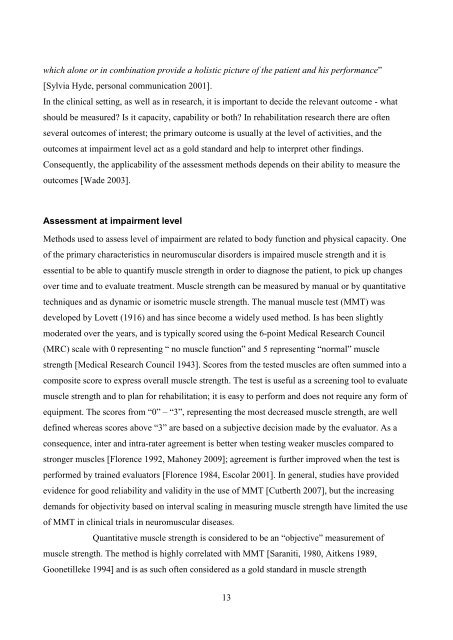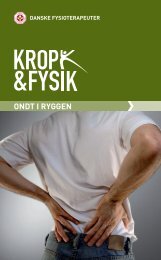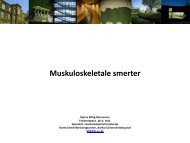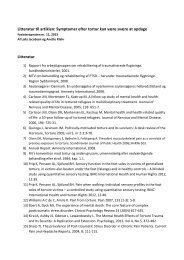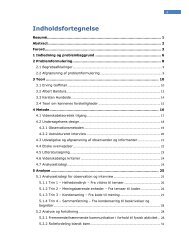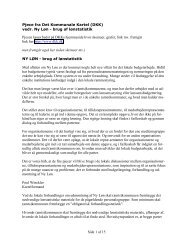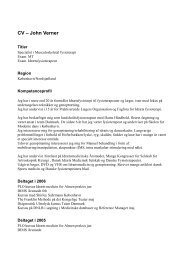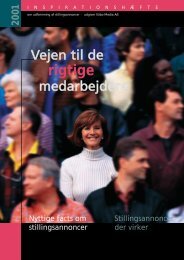Ulla Werlauff Methods to assess physical functioning - Danske ...
Ulla Werlauff Methods to assess physical functioning - Danske ...
Ulla Werlauff Methods to assess physical functioning - Danske ...
You also want an ePaper? Increase the reach of your titles
YUMPU automatically turns print PDFs into web optimized ePapers that Google loves.
which alone or in combination provide a holistic picture of the patient and his performance”<br />
[Sylvia Hyde, personal communication 2001].<br />
In the clinical setting, as well as in research, it is important <strong>to</strong> decide the relevant outcome - what<br />
should be measured? Is it capacity, capability or both? In rehabilitation research there are often<br />
several outcomes of interest; the primary outcome is usually at the level of activities, and the<br />
outcomes at impairment level act as a gold standard and help <strong>to</strong> interpret other findings.<br />
Consequently, the applicability of the <strong>assess</strong>ment methods depends on their ability <strong>to</strong> measure the<br />
outcomes [Wade 2003].<br />
Assessment at impairment level<br />
<strong>Methods</strong> used <strong>to</strong> <strong>assess</strong> level of impairment are related <strong>to</strong> body function and <strong>physical</strong> capacity. One<br />
of the primary characteristics in neuromuscular disorders is impaired muscle strength and it is<br />
essential <strong>to</strong> be able <strong>to</strong> quantify muscle strength in order <strong>to</strong> diagnose the patient, <strong>to</strong> pick up changes<br />
over time and <strong>to</strong> evaluate treatment. Muscle strength can be measured by manual or by quantitative<br />
techniques and as dynamic or isometric muscle strength. The manual muscle test (MMT) was<br />
developed by Lovett (1916) and has since become a widely used method. Is has been slightly<br />
moderated over the years, and is typically scored using the 6-point Medical Research Council<br />
(MRC) scale with 0 representing “ no muscle function” and 5 representing “normal” muscle<br />
strength [Medical Research Council 1943]. Scores from the tested muscles are often summed in<strong>to</strong> a<br />
composite score <strong>to</strong> express overall muscle strength. The test is useful as a screening <strong>to</strong>ol <strong>to</strong> evaluate<br />
muscle strength and <strong>to</strong> plan for rehabilitation; it is easy <strong>to</strong> perform and does not require any form of<br />
equipment. The scores from “0” – “3”, representing the most decreased muscle strength, are well<br />
defined whereas scores above “3” are based on a subjective decision made by the evalua<strong>to</strong>r. As a<br />
consequence, inter and intra-rater agreement is better when testing weaker muscles compared <strong>to</strong><br />
stronger muscles [Florence 1992, Mahoney 2009]; agreement is further improved when the test is<br />
performed by trained evalua<strong>to</strong>rs [Florence 1984, Escolar 2001]. In general, studies have provided<br />
evidence for good reliability and validity in the use of MMT [Cutberth 2007], but the increasing<br />
demands for objectivity based on interval scaling in measuring muscle strength have limited the use<br />
of MMT in clinical trials in neuromuscular diseases.<br />
Quantitative muscle strength is considered <strong>to</strong> be an “objective” measurement of<br />
muscle strength. The method is highly correlated with MMT [Saraniti, 1980, Aitkens 1989,<br />
Goonetilleke 1994] and is as such often considered as a gold standard in muscle strength<br />
13


